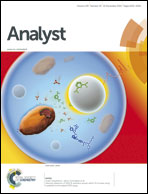Characterization of the herb-derived components in rats following oral administration of Carthamus tinctorius extract by extracting diagnostic fragment ions (DFIs) in the MSn chromatograms†
Abstract
In this study, a new strategy named extracting diagnostic fragment ions (DFIs) in the MSn chromatograms [E(DFI)MSnCs] was proposed to rapidly detect and identify the in vivo components derived from the extract of Carthamus tinctorius (ECT), using high performance liquid chromatography coupled with hybrid ion trap-time of flight mass spectrometry. In order to comprehensively summarize the DFIs for the global identification of in vivo constituents of ECT, chemical profiling was carried out, and then the typical metabolic pathways of the primary components were proposed according to their chemical categories, by orally administering representative reference compounds. Based on the proposed metabolic pathways and the fragmentation rules, a list of DFIs was constructed and adopted to differentiate and identify the metabolites from the endogenous substances in the MSn chromatograms of ECT-treated biological samples, in combination with the neutral loss scan mode as a supplement. As a result, a total of 156 compounds were tentatively assigned in vivo, including 63, 73, 50, and 17 components from rat plasma, urine, bile, and feces, respectively, following oral administration of ECT. Deglycosylation, oxidation, methylation, sulfonation, and glucuronidation were observed as the major metabolic pathways for the chemical constituents of ECT, and dehydroxylation was detected at the A-ring of flavones for the first time. The findings suggested that the E(DFI)MSnCs-based strategy which integrated ideas from single compounds to herbal extracts and from extract chemical profiling to in vivo metabolite profiling, could be used as a reliable tool for rapidly discovering and identifying herb-related constituents in vivo.


 Please wait while we load your content...
Please wait while we load your content...